Time to read: 15 minutes
In January 2020 I realized an almost lifelong dream to see Mount Everest. I had booked an 8-day Everest Base Camp Tibet tour for the Spring Festival (Chinese New Year).
Unlike on the Nepal side where you need to hike for weeks to get there, it’s possible to drive to Everest from Lhasa in Tibet, making it a lot easier to access.
Below I will recount the details of my trip and how you can go about arranging your own once-in-a-lifetime visit to Tibet Everest base camp and the roof of the world.
There are a lot of rumors concerning travel to Tibet as it is a sensitive region. However, I found the whole process very easy, and once there the situation was nowhere near as tense as in Xinjiang Province where security is much tighter.
Boring stuff: I have visited each of the places I recommend and give you my honest opinion, warts and all. All photos are my own unless otherwise stated and may not be reproduced without permission. Affiliate links may earn a commission at no extra cost to you.
Choosing the Right Tibet Everest Base Camp Tour
There are many companies offering Tibet Everest Base camp tours, and most of the tours follow a similar itinerary. One of the most popular is the 8-day tour as it includes many of Tibet’s top attractions in addition to Everest. Click here for more information.
The 8-day tour is also better than shorter tours as it allows plenty of time for acclimatization. Here are a few different options to choose from:
4-Day Lhasa & Everest Base Camp Tour
7-Day Lhasa to Kathmandu Tour via Everest
8-Day Lhasa, Everest, Shigatse and Gyantse Tour
13-Day Lhasa, Everest, Kailash and Kathmandu Tour
Useful Information for Visiting Tibet Everest Base Camp
Travelling to Everest Base Camp in Tibet is relatively straightforward and I found it easy to plan with the assistance of my tour company which helped secure the necessary paperwork. Below you’ll find details of what you need in order to see Mount Everest from Tibet.
To visit Everest Base Camp on the Tibet side you must have the following paperwork:
- A Chinese visa that is valid for the length of your stay in Tibet
- A Tibet Travel Permit
- An Alien’s Travel Permit (for the border area where Everest is located)
You must apply for a Chinese visa at your nearest Chinese embassy or consulate, preferably in your home country.
Although to apply for the Chinese visa you need to state an itinerary, it’s probably best to not mention Tibet (it doesn’t matter if you deviate from the itinerary you put on your visa application).
Your tour company will apply for your Tibet Travel Permit and Alien’s Travel Permit. You must have your Chinese visa before these permits can be applied for.

What is Included on a Tibet Everest Base Camp Tour
Most EBC Tours include the following. Check with your tour operator to see what’s included.
- Airport/station Pick-up and transfer
- 3* Hotel in Lhasa and Shigatse (based on two people sharing)
- Tent or Guesthouse* at Everest Base Camp
- Breakfast (EBC not included)
- English-speaking guide
- Comfortable coach/minivan and driver
- All Tibet travel permits
- Museum/temple entrance fees
- Welcome dinner
Itinerary

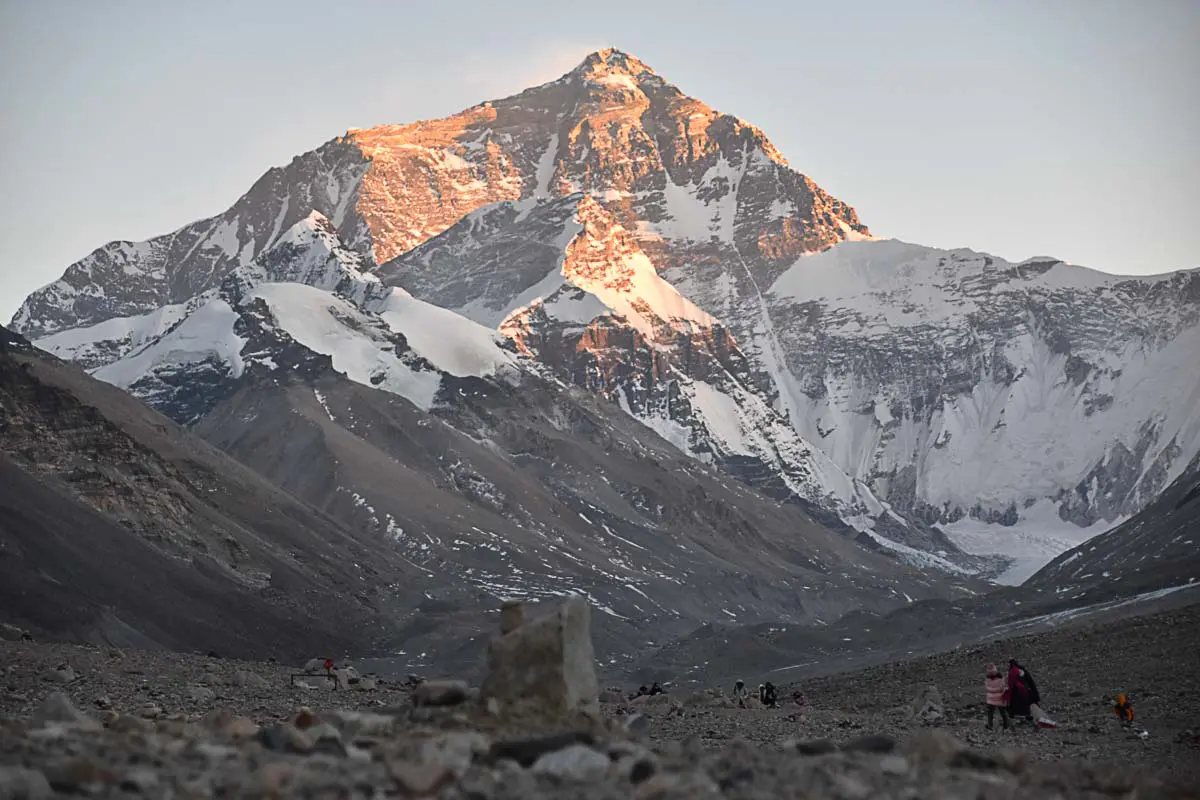
Below is the advertised itinerary from Experience Tibet. My tour departed slightly from this due to late arrivals etc (everything was included but some of the days were swapped around). These are the main attractions featured in almost every Tibet Everest base camp tour, regardless of the tour operator.
Day 1 – Arrival in Lhasa
- Pick up from station or airport
- Free time in Lhasa
Day 2 – Lhasa
- Potala Palace
- Jokhang Temple
- Barkhor Street
Day 3 – Lhasa
- Drepung Monastery
- Sera Monastery
Day 4 – Lhasa – Gyantse – Shigatse
- Yamdrok Lake
- Karola Glacier
- Pelkor Monastery
Day 5 – Shigatse – Everest Base Camp
- Rongbuk Monastery
- Everest Base Camp Tibet
Day 6 – Everest Base Camp – Shigatse
- Everest Base Camp
- Yarlang Tsangpo River
Day 7 – Shigatse – Lhasa
- Tashilunpo Monastery
- Free afternoon in Lhasa
Day 8 – Lhasa
- Transfer to railway station or airport
How Much Does a Tibet Everest Base Camp Tour Cost?
I paid ¥5,950 ($850) for my eight-day Tibet Everest Base Camp Tour.
The price depends on the season. I went in January which is low season (but with the best chance of clear, blue skies).
Below are the current 2022 prices from Experience Tibet
| Season | Price in Yuan ¥ | Price in USD $ |
| Jan – Mar | ¥5,950 | $850 |
| Apr – Jun | ¥6,300 | $900 |
| Jul – Aug | ¥7,000 | $1,000 |
| Sep – Oct | ¥6,650 | $950 |
| Nov – Dec | ¥5,950 | $850 |
How to get to Tibet
Train: the Qinghai Express runs on the highest railway line in the world. There are multiple daily services between Xining and Lhasa (with connections to the rest of mainland China). You find out all you need to know about the Xining to Lhasa train in my article about the Qinghai Express.
Flight: Tibet is served by Lhasa’s Gonggar Airport with flights to and from most major cities in China. There are no international flights to Tibet so you must first arrive in mainland China and transfer.
From Nepal: The road between Nepal and Tibet has reopened after the catastrophic 2015 earthquake.

Getting to everest from Tibet
Your tour will include transport by bus or minivan from Lhassa to EBC. The journey usually takes around two days with an overnight stop in Shigatse.
In years past one had to join a tour group of at least five other people of the same nationality, but this rule seems to have been scrapped. I was able to book onto a tour with Experience Tibet for a very reasonable price, and who took care of all the permits needed for a visit to Mount Everest. Get Your Guide is another reputable company that offers tours to the region.
I decided I would travel to Lhasa by train on the legendary Qinghai Express; the world’s highest railway. Travelling by train is the best way to start any trip to Tibet as not only is the scenery out of this world, it helps with the acclimatization process. If you fly straight to Lhasa (which sits at 3,656 metres / 11,990 feet) from sea level then the risk of suffering altitude sickness early on is a lot higher than arriving by train.
Preparations for my Tibet Everest Base Camp Tour

After finalizing the arrangements with the tour company who only required a copy of my passport to set things in motion, I set about trying to cover the recommended packing list. This included a down jacket, some new winter boots and plenty of layers to protect against the cold Himalayan winter.
Five years before, I lived in the city of Harbin which is one of the coldest cities in the world (-30 was not uncommon) but I had foolishly gotten rid of most of my winter gear when I moved farther south.
I was very keen to get hold of some Diamox which is an altitude medication, but unfortunately, it is not available in China. Friends recommended an herbal substitute but I found this next to useless when suffering the effects of altitude.
As a precaution, I was able to get hold of some Aspirin which can help as it thins the blood and alleviates some of the symptoms.
I secured my rail tickets for the whole route with ease using the Trip.com app and was all set to go!
Setting off for Tibet and Everest Base Camp
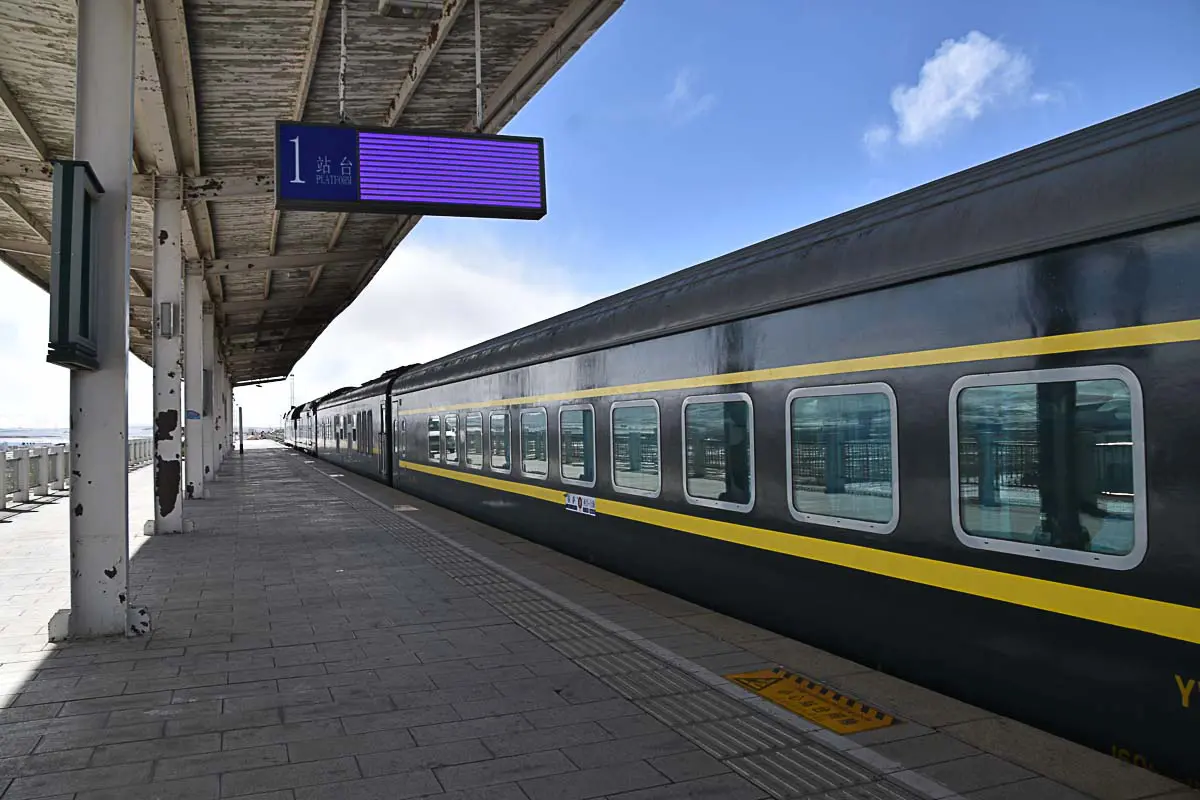
In mid-January, I set off from my home in Luoyang for Xining in Qinghai Province, and considered the gateway to Tibet.
Upon arriving at Xining Station, I noticed the drop in temperature. Tibetan families and workers waited outside the station to travel home during the holidays in China. They looked similar to Mongols or ancient Kazakhs with dark, weather-beaten faces and colored woolen clothing.
After going through security and showing copies of my Tibet Travel Permits I entered the train. I had booked a hard sleeper, which is not as bad as it sounds (a cabin with 6 beds and perfectly comfortable).

The trains that run this route are specially equipped for the altitude and include vents pumping in oxygen and have a doctor on board. Not long after the line opened in 2007 a passenger died of altitude sickness, so these precautions are necessary.
The carriage attendant handed out disclaimers to all the passengers that needed to be signed and returned, stating that we didn’t have any underlying health conditions.
I settled into my bed for the night and popped a couple of aspirin to mitigate the effects of the altitude. The railway reaches a height of 5,200 metres (17,000 feet) which is pretty high! I managed to sleep well, as I always do on trains.
Day two on the highest train in the world

I awoke early with a headache and shortness of breath, but this was to be expected. I downed a couple of aspirin and sat glued to the window. The landscape was like nothing I have ever seen before. Everything was white as far as the eye could see. Snow blew across the tops of huge mountains in the distance.
At intervals, there were little huts along the railway where a policeman or woman would come out and salute the train as it rolled past which I thought was quite a nice touch.
Beyond them the plateau stretched towards the high peaks of the Himalayas and yaks grazed, looking for grass under the snow. I saw the odd eagle overhead and noticed that the sky was the deepest shade of blue I had ever seen.
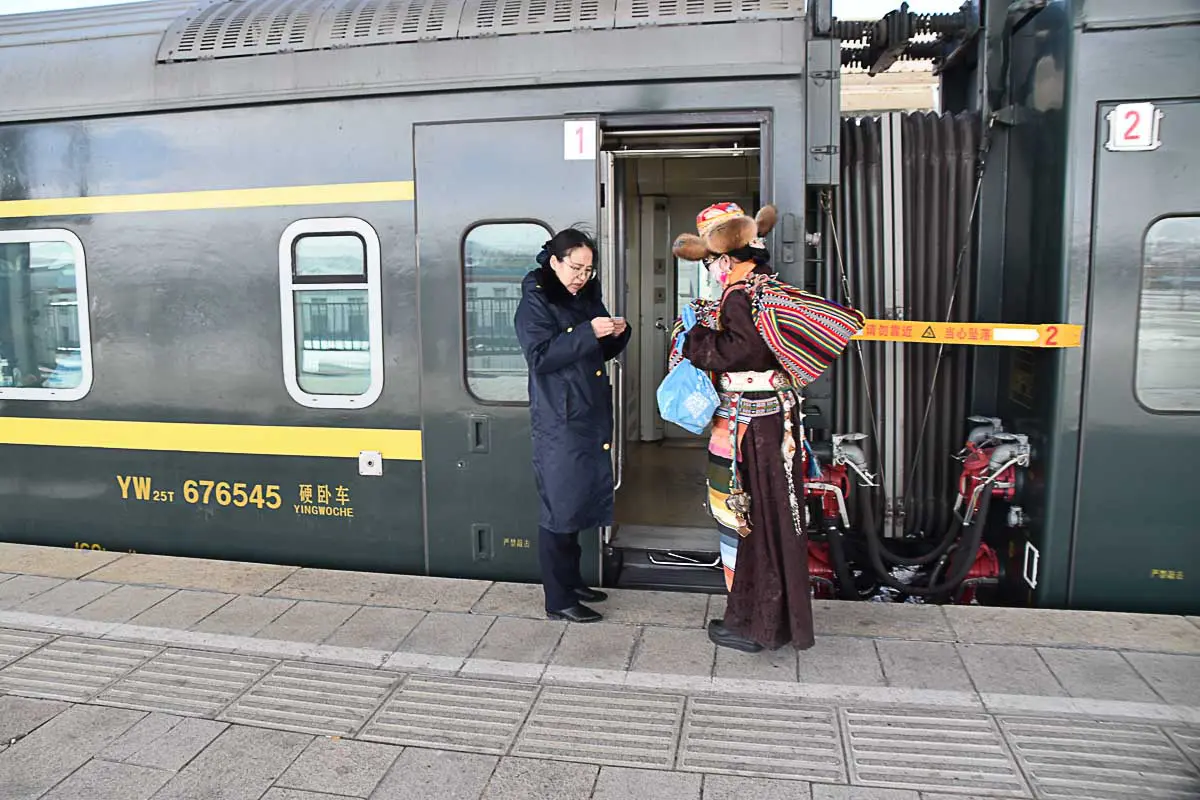
By lunchtime, I was feeling quite lightheaded and simple tasks now took a lot of exertion. Tying my shoelaces had me breathless and walking to the restaurant car was a lot of effort. On the way, I saw a Chinese lady sitting on a seat in the carriage with oxygen tubes coming from the wall and into her nose!
I enjoyed a very nice meal in the restaurant car but it was one of the most expensive I’ve had in China (around $15). I could have ordered the same in a restaurant in any city for less than $5, but I wanted to sit and enjoy the view in the comfort of the restaurant.
The good thing about the slow trains in China is that they have an onboard kitchen and you can be lucky and get a really decent meal, unlike the reheated gloop on the fast trains.
Arriving in Lhasa
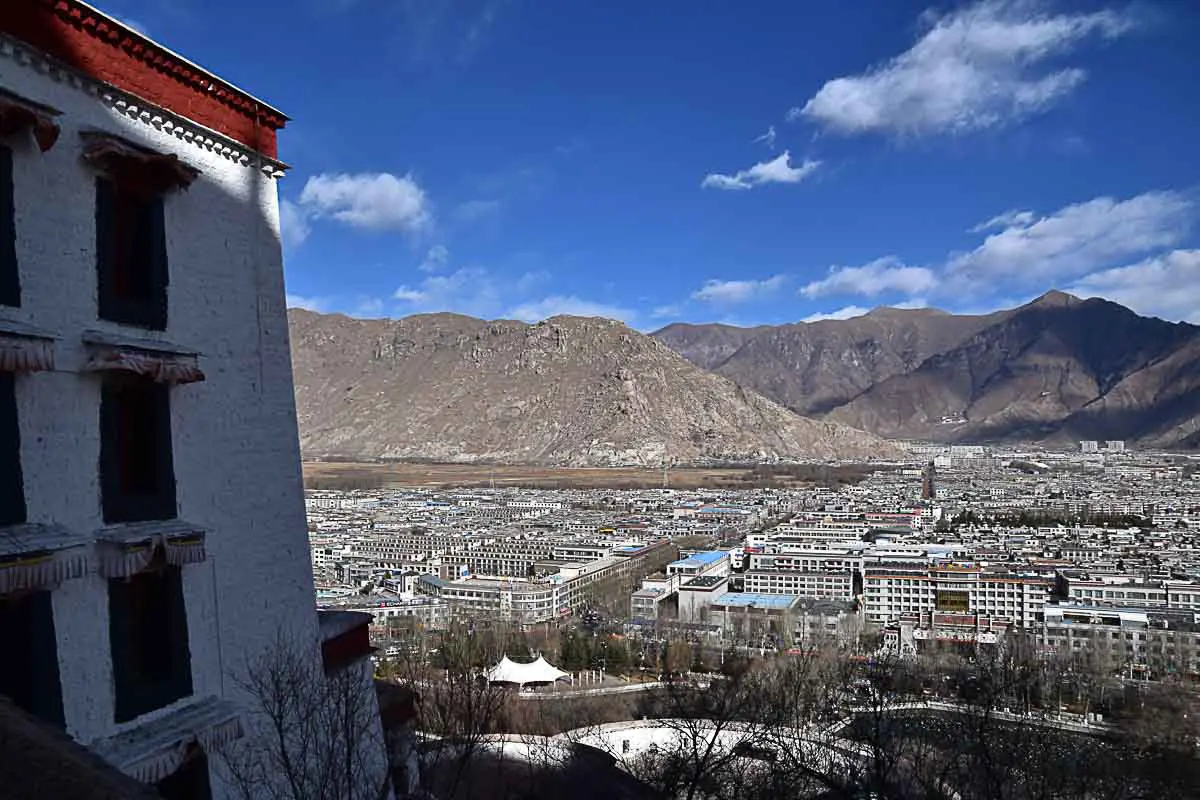
Shortly before arriving in Lhasa, the train reached the highest point of the tracks at a station called Tanggula (which is in the Guinness Book of World Records as the highest station in the world). I was able to leave the train briefly and snap a couple of pictures, but the wind and cold were oppressive!
The train then started making the descent towards Lhasa, where I was met by my guide, Tenzing; what an auspicious name for the person that would be taking me to Everest (Tenzing Norgay was the first Sherpa to reach the summit of Everest along with Sir Edmund Hillary on 29th May 1953).
After leaving the train I was immediately taken to a police office to complete the necessary paperwork and have my permits inspected. I was then taken to my hotel a short drive away. It was dark, but Tenzing pointed out a few sights and I managed to glimpse the illuminated Potala Palace
Lhasa and the Potala Palace

I spent two days in Lhasa getting to know the tour group (there were 24 of us from various countries around the globe) and we were split into two groups each with our own guide. On the first day we explored the magnificent Drepung and Sera Monasteries.
The former clinging to the mountainside above Lhasa with magnificent views across the city. The latter is famous as the home of the debating monks, who congregate in a courtyard to talk animatedly about the Buddhist scriptures.
The following day we explored the Potala Palace which was another highlight and something I’d been looking forward to seeing for some time. We explored Jokhang Temple in the center of the city and ate at a wonderful Tibetan Restaurant nearby.
Food in Tibet
The menu consisted heavily of Yak, which tastes very much like beef. We tried several dishes and I washed them down with a beer which I came to regret later that night.

Our guide had told us that Buddhists are usually vegetarian or vegan but do occasionally eat yak meat. He explained that Buddhists never eat small animals or fish as the number needed to satisfy a person is greater than that of one large animal.
I’m not sure that the western vegan crowd would agree, but I think it’s a pretty sound philosophy. The fewer animals killed for consumption the better, and if one yak will feed a Tibetan family for a year, that’s got to be better than a couple of chickens and fish each week surely?
The Drive to Everest Base Camp

To drive to Everest Base Camp would take a two-day journey across the Himalayas. We would make several stops on the way including lakes, glaciers and other Tibetan towns and cities such as Gyantse and Shigatse, the latter where we would spend the night.
It was an early start and we left Lhasa at around 7:30 am. We were packed into two minibusses which were large enough to be comfortable and I managed to secure a single seat next to the window. After leaving the city we drove across the plateau towards towering mountains.
It was surprising to note the sandy-red color of the mountains and passes, as the snows of the train journey were nowhere to be seen. It looked more like a desert landscape at times with the sun beating down under an azure blue sky.

Yamdrok Lake
As we started to climb a little higher on our drive to Everest Base Camp, we made our first stop at a lakeside where we had a few minutes to take photos and use the toilets. The scenery was beautiful but modest. We continued up along winding roads and the views became more and more spectacular as we crested high mountain passes.
After around four hours on the road, we crested Gampala Pass at 4,790 metres (15,700 feet) where we stopped to take in the views of the stunning Yamdrok Lake below.
The lake stretched from horizon to horizon and behind it rose the first snow-capped mountains I had seen since the train. We stopped again at the lakeside for more photos, and the wind coming down from the mountains was so strong it almost knocked me off my feet.
The Karola Glacier

We hit the road again and wound our way through the mountains until we stopped at the Karola Glacier, another first for me as I had never seen a glacier before in real life!
We were able to get quite close to the bottom of the ice flow and I couldn’t help noticing that it looked like compacted soundwaves or the cover to Joy Division’s Unknown Pleasures, but in white.
Later we arrived in Gyantse and had a look around Pelkor Monastery and its unique stupa (burial monument). There was a large fortress on the hillside above the town and our guides informed us that this was a British garrison built after the British Army crossed over from India 200 years before.

It was around 8pm by the time we arrived in Shigatse. I was utterly exhausted from the long journey and altitude but my mind was racing trying to assess everything I had seen so far. The journey seemed to be upping the game as we turned every corner and a new sight would imprint itself onto my mind and memory. There was so much to process and take in it was overwhelming.
A Strange Coincidence

I was sharing my room with a friendly Spanish guy named Oscar who had been living and teaching in Chengdu. We decided to go out and find somewhere to eat and met up with some others from the tour at a nearby restaurant.
After a pleasant couple of hours chatting with the others, we made our way back to the hotel as everyone was tired from the journey. It would be another early start and tomorrow would be the day we cast our eyes on the prize; Chomolungma – Mother Goddess of the Earth. Mount Everest; the highest peak on planet earth!
First Views of Everest from Tibet
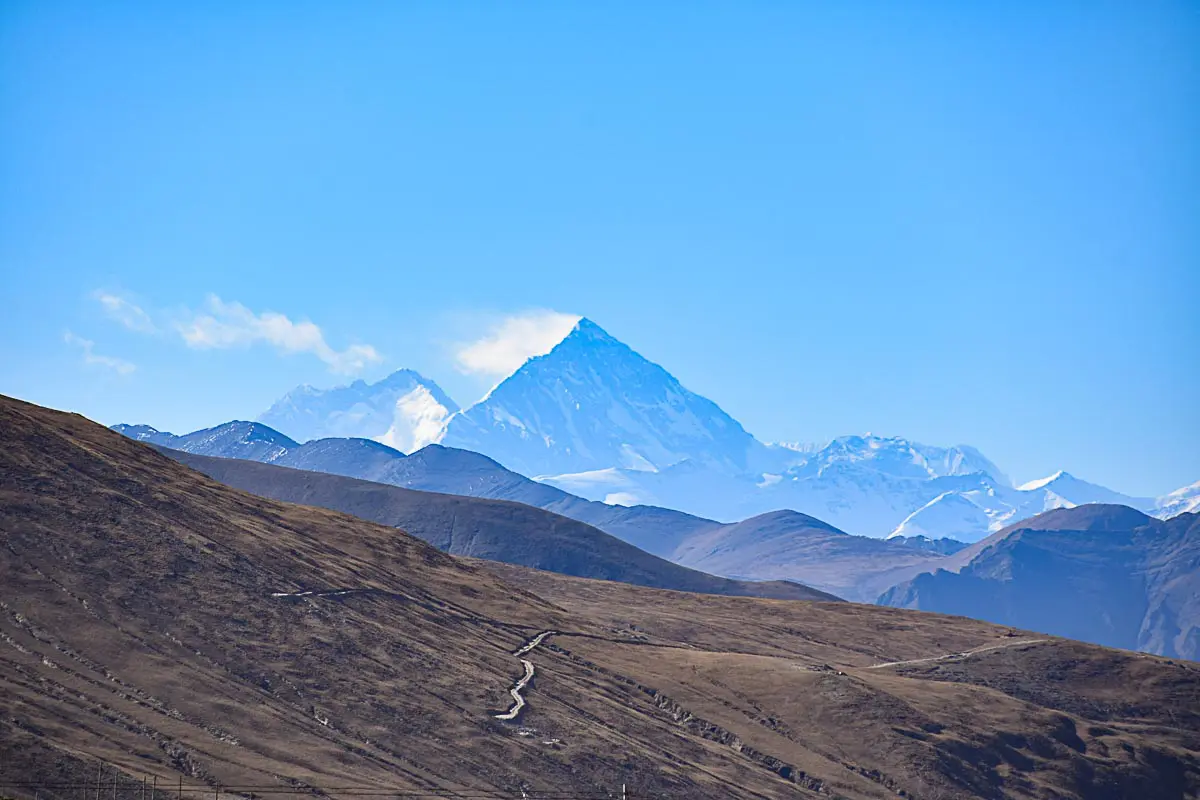
After a sumptuous breakfast (seriously, it was amazing) we boarded the minibusses for the final leg of the journey. Behind us, the sandy red mountains stretched into the distance, and in front was a world of white underneath jagged peaks reaching to the heavens.
We carried on into the mountains and then suddenly and unmistakably I caught a glimpse of what must have been Everest out the corner of my eye. Our stopping shortly thereafter confirmed that it was indeed Everest.
Everyone piled out of the buses giddy with the excitement of laying eyes on this most majestic of mountains. It looked truly incredible as the wind-blasted snow from the peak into the sky. It looked almost like a perfect triangle, high above the other peaks around it.
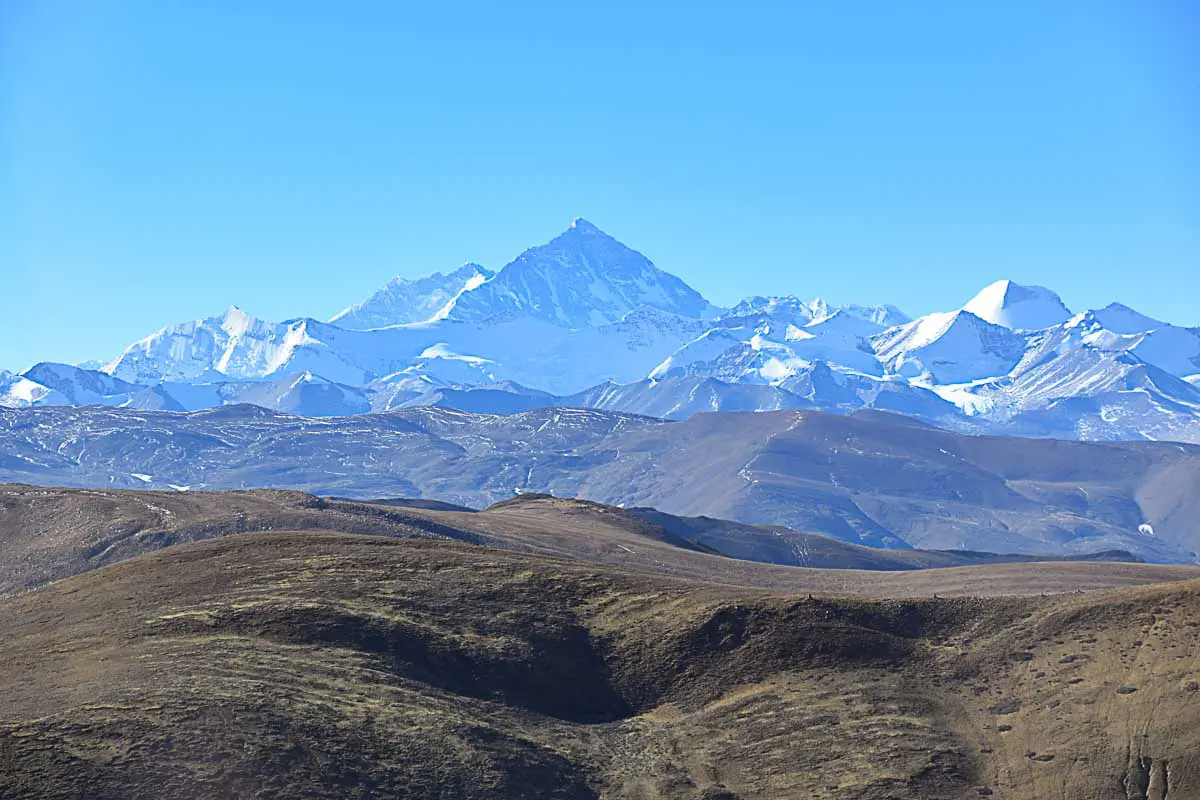
Chomolungma National Park
Our first stop was at the entrance to the Chomolungma National Park where we had to queue up and show our permits for the border area (Everest spans both Tibet and Nepal). After 30 minutes or so we were back on the road and then embarked on a nauseating series of hairpin bends that seemed to go on, and on and on.
Our driver thought it would be fun to try and “drift” around the corners (which were mostly without barriers). The ascent was rapid and with every turn, we got higher and higher. I don’t know the altitude of the pass we started from, but within a few minutes, it was a very long way down!
The Final Stretch – Arriving at Tibet Everest Base Camp

Eventually, we reached the top of the pass. Looking north the mountains were the same sandy brown color, but to the South, the peaks were granite-grey and covered in snow.
We stopped again at the top of the pass for uninterrupted views across the Himalayas. In front of us were five of the highest mountains in the world; Lhotse, Nuptse, Makalu, Cho Oyu, and of course, Everest.
Prayer flags fluttered violently in the strong wind which came rushing across the plateau. The cold, wind and altitude made it quite uncomfortable, but no one wanted to leave the view.
We continued on for another couple of hours, descending and rising over various high passes. Along the bottom I noticed some old abandoned buildings which looked like old forts.

The Final Leg
Just before the final few kilometres to Base Camp, we pulled into a car park in a small village. Here we were to swap busses and enter an electric vehicle for the final leg. I was pleased that the authorities take preserving the environment here so seriously.
After 30 minutes or so we arrived in the tiny settlement of Rongbuk. There were a few stone houses, the famous monastery and what looked like a stable but which was in fact our “hotel”. Everest dominated the entire scene. It was impossible not to be awed by this monolith in front of us.

We were shown to our rooms. I was to be sharing with five others. There was just one long bed with layers and layers of quilts and blankets. We were given electric blankets to put underneath our sleeping space, and I managed to get space next to the wall and window. I left my bags and went off to spend some alone time with the mountain.
Mount Everest

Our accommodation was directly opposite Rongbuk Monastery. Yaks wandered around outside and the sky darkened as the sun dropped behind the vast peaks of the Himalayas. There was still a couple of hours until total darkness so I walked the kilometre or so down to the new Base Camp.
In February 2019 the Chinese authorities banned tourists from visiting base camp as they embarked on a clean-up operation to remove waste left by climbers which had accumulated to significant proportions. Climbing season is March to May when a small weather window allows access to the summit which is usually battered by the jet stream.

We were able to visit the new EBC (Everest Base Camp) located at 5,200 metres (17,000 feet) but due to the time of year the only people there were a few other tourists. Due to the coronavirus, the 2020 climbing season would be canceled altogether!
I spent around two hours at the camp just sitting and drinking in the surroundings. It didn’t quite feel real to be sitting in such close proximity to such a landmark. After a while, my neck started to ache and my head spun from the altitude. Although I had acclimatized somewhat, it was still an effort to move and even just sitting down my head throbbed.
A night under Everest

As the sun set the sky was covered in a million tiny pinpricks as the stars came out above the Himalayas. It was the clearest sky I had ever seen in my life and looked incredible. I would have liked to have tried to take some photos but I didn’t bring my tripod, unfortunately.
We all went to bed around 10 pm as there wasn’t much to do except try and keep warm amidst the freezing winter temperatures.
I went to bed fully clothed and still with my hat on to try and ward off the cold. In the morning, I noticed that my water bottle had frozen solid inside the room! I managed to sleep relatively well thanks to popping a couple of aspirin before bed.
The next morning, we had an hour or so to spend at base camp before making the two-day journey back to Lhasa.
What is the best time for a Tibet Everest Base Camp Tour?

Winter is definitely the best time for a Tibet Everest Base Camp Tour as there is a much higher chance of clear skies and uninterrupted views of the mountain. Summer is the monsoon season so there is a lot of rain and the views can be obscured by clouds.
How to book a Tibet Everest Base Camp Tour
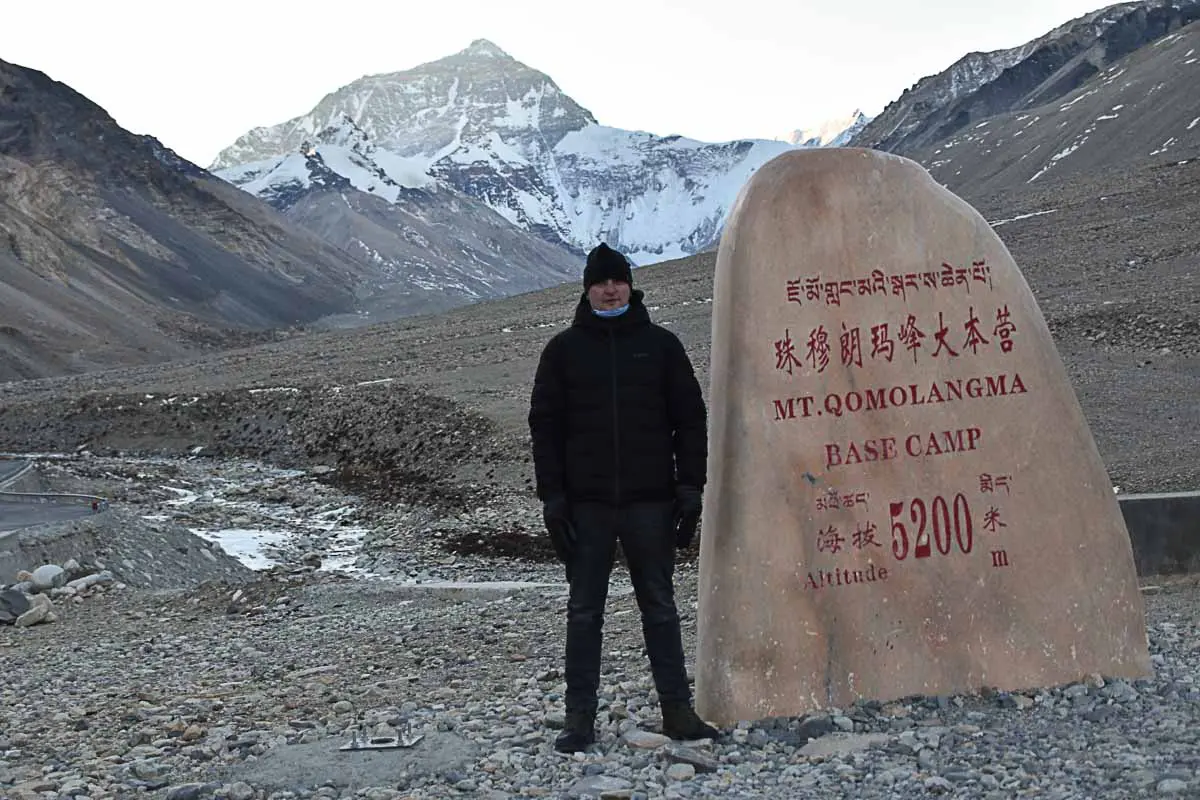
Get your guide has many Tibet Everest base camp tours which include visits to Lhasa, Yamdrok Lake and more. Click the links below to check out some of these.
If you are looking for a more adventurous way to reach Everest, then the Everest Base Camp Trek in Nepal is a great way to see the world’s tallest peak.
Read my other articles about Tibet
- Xining to Lhasa Train (the highest railway line in the world)
Looking for more things to do in China? Check out this list of amazing China landmarks.
Frequently Asked Questions
Yes, in addition to a Chinese visa, you will also need a Tibet travel permit and a permit for visiting Everest. This will be arranged by your tour company.
Prices start at around $800.
The highest you will ascend is 5,200 metres (17,060 feet).

About the author:
Steve Rohan is a writer from Essex, England. He has traveled to over 60 countries, lived in Armenia, China and Hong Kong, and is now living the digital nomad life on the road.
Steve prefers “slow travel” and has covered much of the world by train, bus and boat. He has been interviewed multiple times by the BBC and recently featured in the documentary Scariest Places in the World. See the About page for more info.
Where I am now: Yerevan, Armenia 🇦🇲



